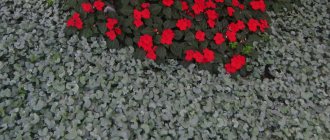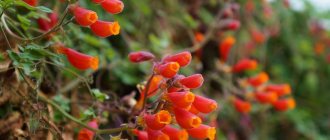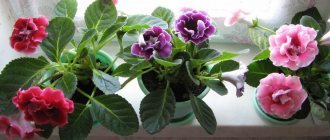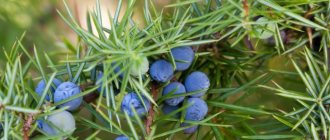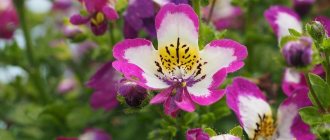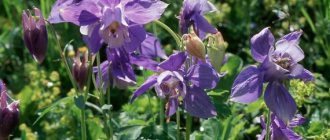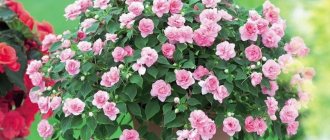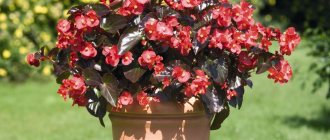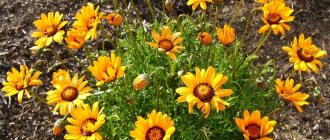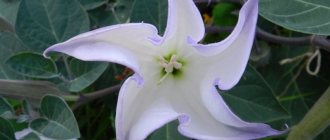Venidium belongs to the category of herbaceous plants and is a representative of the Asteraceae. It grows in the wild in South Africa. In temperate climates, the crop is grown as an annual, and in southern countries it can delight the gardener for many years.
The appearance of the flower resembles a chamomile or sunflower, which is why it is also called “African chamomile.” It has beautiful large inflorescences with contrasting petal colors and large dark green leaf plates.
Venidium is represented by twenty varieties, but only a few of them are common in our climate zone.
Although the flower is a rare guest in our gardens, if you grow it on your own plot, you will definitely be satisfied. [Hide]
Content
- Types and varieties
- Venidium planting and care in open ground
- Watering Venidium
- Primer for Venidium
- Feeding Venidium
- Venidium transplant
- Venidium flowering
- Trimming and gartering Venidium
- Preparing Venidium for winter
- Reproduction of Venidium
- Diseases and pests
- Conclusion
Growing Venidium from seeds
Fans of large and bright African daisies will also appreciate the exotic Venidium - a beautifully flowering plant covered with cobwebby-silver pubescence. Its large, contrastingly colored flowers bloom continuously throughout the summer and warm autumn against the backdrop of a dense bush with lobed leaves.
Single inflorescences-baskets of Venidium consist of reed flowers (with a dark or contrastingly colored base) and a shiny black disk of tubular flowers
The amazing play of light and dark colors characteristic of the Venidium inflorescence fascinates and attracts everyone’s attention to this elegant plant! I recommend that readers of the GreenColor website grow charming Venidium to decorate their gardens and balconies.
I recommend that readers of the GreenColor website grow charming Venidium to decorate their gardens and balconies.
Venidium lush in floriculture
Lush Venidium (Venidium fastuosum) is used more often than other species in floriculture in different countries. This spectacular, truly lush annual plant wonderfully decorates the garden and balcony throughout the entire gardening season with its very large (10-12 cm in diameter), eye-catching flowers.
Tall varieties of Venidium lush are quite large plants, reaching 60-70 cm in height. They look wonderful in sunny flower beds. Cut Venidium inflorescences last a long time in a vase.
The most common varieties of Venidium:
Prince Zulu - has white reed flowers with a light brown ring at the base; Orange Prince - with bright orange flowers.
Of particular value for gardeners are the universal dwarf hybrids of Venidium (Dwarf Hybrids) up to 30 cm high, which are suitable for growing in a container and even for a small alpine hill. Low-growing, dense bushes feel great in garden flowerpots and window boxes. Dwarf Venidium
content with a small amount of soil in a container, grows successfully and blooms profusely on a south-facing balcony.
Growing Venidium from seeds
You can sow Venidium in a pot (followed by picking the seedlings into cups). Or you can sow 2-3 seeds at once in cups (followed by cutting off the weakest seedlings and leaving one strong sprout). Drainage holes in the containers used are required.
At first, it is better to cover the Venidium crops with a film, but when the first shoots appear, you need to immediately remove it (wet conditions are harmful to this plant). High-quality Venidium seeds germinate quite quickly at room temperature, seedlings appear in about 1-1.5 weeks. Venidium is watered only after the soil has dried. Strong shoots develop quickly, strong seedlings are easy to pick. Pinching the tops of young plants stimulates the formation of dense bushes.
If you don’t want to bother with seedlings at home, for early flowering you can sow Venidium in a garden greenhouse or greenhouse in April (followed by transplanting the grown seedlings with a clod of soil to a permanent place after the onset of stable heat). You can sow Venidium directly in open ground in May, but you need to protect the seedlings from possible frosts.
Planting seedlings and caring for Venidium
Heat-loving Venidium grows well and blooms profusely in a sunny place. The soil for it is preferable to be nutritious and light, well-drained.
An adult Venidium bush has a wide and highly branched bush, which must be taken into account when planting grown seedlings in a permanent place. The recommended distance between neighboring seedlings is 25-30 cm
In this case, they do not interfere with each other, and most importantly, they are well ventilated, which is especially important during prolonged rains. Otherwise, the plants run the risk of getting sick.
For the same reason, you should not get carried away with excessive watering of drought-resistant Venidium - waterlogging of the soil can provoke the appearance of a fungal infection. Only during a long period of extreme heat and drought does this very hardy African plant need watering to maintain its decorative appearance.
Venidium lush blooms non-stop for several months in a row, requiring almost no care. Removing flowering heads promotes the formation of a large number of new buds. Tall varieties of Venidium can suffer from strong winds and heavy rains, so support is desirable for large tall bushes.
Venidium
and other bright African daisies (Arctotis, Gazania, Ursinia, Dorotheanthus, Dimorphotheca, Osteospermum, Mesembryanthemum) are very grateful plants. They delight us with their elegant flowers throughout the garden season, content with minimal care.
Types and varieties
Venidium Lush is the most common subspecies of the crop. It is an annual flower reaching a height of up to 70 centimeters with large chamomile-like inflorescences. The plant forms a lush bush with dense dark green foliage. Flowering time lasts from June to September. After flowering, seeds begin to form.
Venidium Prince Zulu - the plant forms wide bushes with small dark green leaf blades. It reaches a height of up to 70 centimeters. The inflorescences are white with light purple stripes at the base of the flower. The heartwood is dark brown. The stem and petals are covered with fine hair. Flowering time lasts from early summer to early autumn.
Venidium Amaretto - the height of the crop reaches up to 80 centimeters. It has dark green, pinnately dissected leaves with hard hairs. The inflorescences are large, resembling a sunflower. The petals are orange, with a purple color closer to the core. The core of the flower has a dark brown tint. Venidium blooms from early June to September.
Venidium Orange - the crop is a hybrid variety and reaches a height of up to 70 centimeters. The plant forms lush bushes with pinnate, pubescent dark green leaf blades. The inflorescences are large, located on high peduncles. The petals are bright orange with a dark center. The flowering time of the plant lasts from early summer to mid-autumn.
Venidium White - the culture reaches a height of up to 60 centimeters and forms a lush shrub with pinnately dissected, pubescent dark green leaves. The inflorescences are medium-sized, located on a high pubescent peduncle. The petals are white with purple-orange strokes located closer to the core. The core of the flower is black-brown. Flowering time lasts from early summer to mid-autumn. The seeds begin to ripen after flowering.
What is Venidium and how to grow it?
Not long ago, an unusual stranger appeared on the plots of domestic flower growers - a spectacular plant resembling a chamomile. In fact, this plant has long been known in world floriculture, but it is still rare in our country.
This beauty is a spectacular herbaceous plant of the Compositae family from South Africa. Among a couple of dozen known species, there are both annual and perennial varieties.
Venidium has alternately arranged pinnately divided or lobed leaves covered with silvery felt pubescence. Quite tall stems (up to 80 cm) are crowned with spectacular basket inflorescences, like other representatives of this family.
The inflorescences consist of tubular and reed flowers, reminiscent of daisies. . Venidium loves warmth, sunny location, protection from winds and good care. Soils are preferably light, fertilized, without stagnant water.
It should be watered regularly, but only after the soil dries out, because Venidium does not tolerate waterlogging. It is even more of a drought-resistant plant; we must not forget that its homeland is Africa. In our latitudes, it is preferable to grow Venidium through seedlings.
Seeds are sown at the end of March or beginning of April in a light soil mixture to a depth of about 0.5 cm and covered with film until germination. At a temperature of 20-22 degrees, seedlings appear after 7-10 days.
After this, the film must be kept slightly open for constant ventilation, so that the young seedlings do not rot from waterlogging. After a few days, the shelter is completely removed and the seedlings are grown in a bright, sunny place, avoiding excessive watering.
At the end of May, after the danger of spring frosts has passed, the seedlings are planted in open ground at a distance of 25-30 cm between plants. In the first days of hot, cloudless weather, young seedlings need to be shaded from the sun's rays to protect them from burns and excessive loss of moisture.
As soon as they take root, they immediately begin to rapidly increase in size. And here you need not to miss the moment and take care of the construction of decorative supports in advance.
The fact is that on fertile soil the bushes grow especially quickly and luxuriantly, and the stems are quite fragile and very susceptible to lodging under the influence of rain and wind. Therefore, a decorative fence for them will be very useful, protecting large, showy flowers from lodging during flowering. By the way, they are very interesting and unusual in their own way, they come in quite large sizes - up to 12 cm in diameter!
They bloom from about mid-summer until frost. They greatly decorate flower beds and stand well when cut - up to 7 days. Most often we sell seeds of lush Venidium, less often - other types.
Lush Venidium (Venidium fastuosum)
is an annual plant found in the wild of South Africa. The densely pubescent stem reaches a height of 70-80 cm, the plant branches strongly, giving lateral shoots. The lower leaves are lyre-shaped, the upper ones are linear-lanceolate, sessile on the stem.
The inflorescences are large, up to 10-12 cm in diameter. The tubular brown-black flowers form a small dense disk, around which are ligulate flowers of white or orange.
At the very base they have purple-brown stripes, which makes the appearance of the flower particularly impressive. Flowers turn their heads towards the sun during the day, like sunflowers. Venidium lush blooms profusely from late June until late autumn.
Venidium calendulaceum
- a perennial from South Africa, grown here as an annual plant. The lyre-shaped leaves are smooth above, covered with white pubescence below. The stems are erect, with strong long peduncles.
Flowers up to 4 cm in diameter with a black center and shiny yellow petals resemble calendula, for which they received their specific name. This Venidium blooms from July to September. Of the pests, black aphids are especially common, which form clusters on the youngest parts of the shoots and feed on their cell sap, leading to deformation of the tips.
Therefore, when it appears, you need to immediately treat the plants with a suitable preparation. Venidium can be planted not only in flower beds, but also in decorative vases, in rock gardens, and create group compositions in large flower beds and on sunny lawns. Thanks to its long flowering, it remains decorative for a long time and decorates the area with its unusual flowers until frost.
Venidium planting and care in open ground
To grow the crop, you can use both seeds and seedlings. In our climate zone, gardeners grow Venidium as an annual. To plant the plants, prepare a bed in the fall, carefully digging it up and adding compost and sand to the soil. In the spring, in mid-April, the seeds are sown in open ground. To do this, the bed is loosened, holes are prepared and seeds are sown in them, sprinkling them on top with a small amount of soil.
The bed for the plant must be well-lit, and the soil must be fertile and drainable. Seeds should not be sown too thickly so that the bed is not thickened. After the seedlings grow up, they need to be thinned out, removing the weakest specimens.
Seedling growing method
As mentioned above, the crop can also be grown using seedlings. For this purpose, in early March, you should prepare a container with fertile soil and sow seeds into it, deepening them 5 millimeters into the soil. After which the planting needs to be sprayed from the dispenser, covered with film and put in a warm and well-lit place. Seedlings must be ventilated daily and the soil moistened from time to time.
The first shoots will begin to appear after 10 days. When the seedlings become stronger, the film should be removed completely. After the appearance of four leaf blades, the seedlings can be planted in open ground, keeping a distance of 30 centimeters between young plants. It is best to plant at the end of May, when the threat of frost has passed.
How to provide care
When planting, special attention should be paid to the presence of sunlight, as well as the quality of the soil, which should be light, fertile and drainable. Under such conditions, Venidium will bloom throughout its flowering period with beautiful and bright flowers.
The annual does not tolerate prolonged heavy rains, but in dry sunny weather it blooms constantly.
If you want to form a flower in the form of a bush, but at an early age the plant must be pinched at the tops. In addition, you should maintain a distance between Venidium and other plants, since the former loves fresh air and circulation. In windy areas, tall shoots must be tied up as they are fragile.
Venidium transplant
Transplantation will be relevant only in the case of transferring seedlings to open ground. The young seedlings, together with the excavator, are carefully moved into the prepared holes, organizing drainage from fine gravel at the bottom.
Then the hole is filled with soil, lightly compacted and watered. After replanting all the plants, the bed can be mulched with sawdust or pine needles.
Venidium flowering
The crop blooms from early summer to mid or late autumn, depending on the variety. The inflorescences of the plant are large, reminiscent of sunflowers. Their colors can be red, white, pink and orange with yellowish-purple streaks on the petals closer to the middle.
After the Venidium flowers, the seeds ripen, which are used by gardeners to propagate the crop.
Diseases and pests
Venidium can be harmed by aphids, which settle on the leaves and stems of the crop and drink its juice. This leads to gradual withering and death of the flower. To destroy the pest, it is enough to treat the plant several times with the Actellik insecticide, diluting it according to the instructions on the package.
In addition to insects, Venidium is threatened by diseases such as powdery mildew and rust, which occur when the soil is waterlogged and air humidity is high. To cope with this problem, the crop should be treated with Bordeaux mixture and the correct watering regime should be established. If plants are severely damaged, they must be removed from the garden bed by treating the soil and adjacent flowers with fungicides.
Features of care
For Venidium, well-lit places with light, fertile, well-drained soil are selected. If these conditions are met, the plant will delight you with abundant and long-lasting flowering. In dry and sunny weather, flowers constantly replace each other, but rainy and damp climates are contraindicated for them. Not only does the number of buds decrease, the plant may even become sick.
After rooting, Venidium immediately begins to actively increase in size. To form a lush bush, you should periodically pinch the tops of the plant.
Heavily branched trees need space for air to circulate freely and evaporate excess moisture, so it is very important to maintain a distance between neighbors
The plant tolerates drought well, so watering is carried out when there is no rain for more than a week. If the bush is very tall, then in windy weather the stems can bend and break greatly, so they are tied up.
In order for new flower stalks to form after the basket has withered, the old stem should be completely removed almost to ground level. Usually, at the site of each cut shoot, two flower buds are formed at once. That is, the bush expands exponentially after each pruning.
On young shoots, clusters of black aphids are sometimes found, which are able to drink all the juices from the plant. If insects are detected, the leaves are immediately treated with exterminators.
